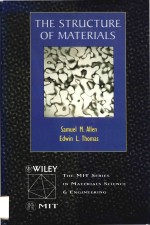图书介绍
The structure of materialsPDF|Epub|txt|kindle电子书版本网盘下载

- Samuel M. Allen ; Edwin L. Thomas 著
- 出版社: J. Wiley
- ISBN:0471000825
- 出版时间:1999
- 标注页数:448页
- 文件大小:54MB
- 文件页数:467页
- 主题词:
PDF下载
下载说明
The structure of materialsPDF格式电子书版下载
下载的文件为RAR压缩包。需要使用解压软件进行解压得到PDF格式图书。建议使用BT下载工具Free Download Manager进行下载,简称FDM(免费,没有广告,支持多平台)。本站资源全部打包为BT种子。所以需要使用专业的BT下载软件进行下载。如BitComet qBittorrent uTorrent等BT下载工具。迅雷目前由于本站不是热门资源。不推荐使用!后期资源热门了。安装了迅雷也可以迅雷进行下载!
(文件页数 要大于 标注页数,上中下等多册电子书除外)
注意:本站所有压缩包均有解压码: 点击下载压缩包解压工具
图书目录
Chapter 1 The Structure of Materials:Overview1
1.1 Descriptors and Averaging3
1.2 Preliminary Concepts5
1.2.1 Symmetry5
1.2.2 Bonding11
Types of Bonds12
Structural Descriptors of Bonded Materials15
Molecular Geometry17
Polyatomic Covalently Bonded Molecules:Electron-Domain Theory18
Shape Diversity in Large Molecules and Macromolecules20
1.2.3 Coordination Number22
1.2.4 Packing Fraction22
1.2.5 Order and Disorder23
1.3 Structure of Materials Roadmap25
References28
Additional Reading28
Exercises28
Chapter 2 Noncrystalline State31
2.1 Generic Descriptors35
2.1.1 Short-Range Order35
2.1.2 The Glass Transition and Free Volume37
2.1.3 Pair-Distribution Function39
2.1.4 Symmetry of Glass Structure and Physical Properties43
2.2 Hard-Sphere Models43
2.2.1 Bernal’s Random Close-Packed Sphere Model44
2.2.1 Voronoi Polyhedra48
2.3 Random-Walk Models51
2.3.1 Brownian Motion and Diffusion51
2.3.2 Polymeric Glasses and Melts56
Thermoplastics57
Polymer Conformations60
Polymer Composition,Architecture and Tacticity61
2.4 Network Models63
2.4.1 Oxide Glasses65
2.4.2 Thermosetting Polymers69
2.4.3 Chalcogenide Glasses72
Xerography:An Application of Noncrystalline Semiconductors73
2.5 Fractal Models74
2.5.1 Dilation Symmetry and Fractal Dimension74
2.5.2 Ordered Fractals76
2.5.3 Irregular Fractals77
2.5.4 Diffusion-Limited Aggregation77
2.5.5 Fractals and Fracture80
References80
Additional Reading81
Exercises81
Chapter 3 Crystalline State89
3.1 The Crystallography of Two Dimensions91
3.1.1 Translational Symmetry91
Lattices91
Primitive Cells,Multiple Cells,and Unit Cells93
Notation for Rational Points and Rational Lines95
3.1.2 Reflectional and Glide Symmetry97
3.1.3 Rotational Symmetry99
Proper Rotation Axes99
Limitation of Rotational Symmetries in Crystals due to Translational Periodicity101
3.1.4 Plane Point Groups103
Derivation of Plane Point Groups by Combining Reflections and Rotations103
General and Special Positions106
International and Schoenflies Symbols107
3.1.5 The Five Distinct Plane Lattices108
Plane Lattice Nets Arising from Crystallographic Rotation Axes and Translations109
Lattice Nets Arising from Mirror Lines and Translations112
3.1.6 Plane Groups114
Addition of Reflectional Symmetry to Plane Lattices116
The Seventeen Distinct Crystallographic Plane Groups117
3.1.7 The International Tables for Crystallography:Plane Groups119
Symbols and Notation120
Description of Two-Dimensional Patterns by Crystallographic Data122
Generation of Two-Dimensional Patterns from Crystallographic Data124
Summary of Information Concerning Plane Groups126
3.2 The Crystallography of Three Dimensions126
3.2.1 Symmetry Operations Unique to Three Dimensions126
Inversion126
Rotoinversion127
Rotoreflection129
Screw Axes130
3.2.2 Techniques for Three-Dimensional Spatial Relationships135
Rational Intercept Plane:Miller Indices135
Direction Common to Two Planes,Zone Axes,Weiss Zone Law138
Spherical Trigonometry140
Stereographic Projection143
3.2.3 Axial Combinations of Rotational Symmetries146
Simultaneous Rotational Symmetries146
Permissible Combinations of Rotational Axes in Three-Dimensional Crystals147
3.2.4 The Thirty-Two Crystallographic Point Groups151
Decomposition of Improper Rotation Axes152
Derivation of Point Groups by Adding Extenders to Permissible Axial Combinations153
Schoenflies Notation for the Crystallographic Point Groups158
Laue Groups159
3.2.5 Space Lattices159
Principles of Derivation by Stacking of Plane Lattices162
The Fourteen Bravais Lattices and Six Crystal Systems166
Conventional Unit Cells for the Crystal Lattices168
3.2.6 Space Groups170
Glide Planes170
Derivation Method for Space Groups172
3.2.7 The International Tables for Crystallography:Space Groups173
3.3 Symmetry Constraints on Material Properties179
3.3.1 Transformation of a Vector181
3.3.2 Transformation of a Tensor181
3.3.3 Tensor Properties of Crystals182
3.3.4 Symmetry Constraints185
3.4 Hard-Sphere Packing and Crystal Structure189
3.4.1 Close-Packed Structures191
3.4.2 Interstitial Sites in Close-Packed Structures194
3.4.3 Close Packing in Ionic Compounds195
3.5 Quasicrystals196
3.5.1 Aperiodic Tiling Patterns197
3.5.2 Icosahedral Structures in Crystals201
References201
Additional Reading202
Exercises202
Chapter 4 Liquid-Crystalline State213
4.1 Structural Classes of Liquid Crystals218
4.1.1 Nematic Phase220
4.1.2 Twisted Nematic Phase221
4.1.3 Smectic Phase223
4.1.4 Columnar Phase226
4.2 Descriptors for Liquid Crystals227
4.2.1 Pair-Distribution Function227
4.2.2 Orientational Order Parameter228
4.2.3 Translational Order Parameter231
4.3 Mesophase Texture and Identification of Liquid-Crystalline Phases233
4.4 Applications of Liquid Crystals233
4.4.1 Surfactants233
4.4.2 Liquid-Crystalline Fibers235
4.4.3 Liquid-Crystal Displays237
4.4.4 Next-Generation Flexible Liquid-Crystal Displays239
4.5 Plastic Crystals242
References242
Additional Reading243
Exercises243
Chapter 5 Imperfections in Ordered Media249
5.1 Point Imperfections251
5.1.1 Vacancies251
5.1.2 Interstitials255
5.1.3 Point Imperfections in Molecular Crystals257
5.1.4 Mobility of Point Imperfections260
5.1.5 Solid Solutions260
5.1.6 Point Imperfections in Ionic Crystals263
Kroger-Vink Notation264
Schottky and Frenkel Imperfections265
Imperfections Associated with Impurities267
5.2 Line Imperfections271
5.2.1 Dislocations273
Evidence for Dislocations276
Characterization of Dislocations:Tangent Vector and Burgers Vector280
Dislocation Motion by Slip and Climb283
Dislocation Loops287
Slip Systems290
Resolved Shear Stress on a Dislocation294
Elastic Energy of Dislocations298
Strengthening Mechanisms in Crystals298
Generation of Dislocations304
Dislocations in Columnar Crystals307
5.2.2 Disclinations307
5.3 Surface Imperfections313
5.3.1 Surface Tension and Surface Free Energy313
5.3.2 Geometry of Grain Structures316
5.3.3 Equilibrium at Interfacial Junctions318
5.3.4 Structure of Crystalline Interfaces321
Stacking Faults322
Antiphase Boundaries324
Grain Boundaries327
Interphase Grain Boundaries332
Grain Boundaries in Block Copolymers334
Magnetic Domain Walls335
Walls in Liquid Crystals339
5.4 Imperfections and Symmetry Breaking340
References340
Additional Reading341
Exercises341
Chapter 6 Microstructure349
6.1 Structural Hierarchies350
6.1.1 Structural Hierarchy in a Metal Forging352
6.1.2 Structural Hierarchy in a Semicrystalline Polymer354
6.2 Microstructures Arising from Special Processing357
6.2.1 Deformation Microstructures358
Deformation Processing and Crystallographic Texture358
Microstructures of Deformed Polycrystalline Materials359
Characterization of Textures:X-Ray Pole Figures361
6.2.2 Transformation Microstructures364
Solidification Microstructures364
Solid-Solid Transformation Microstructures370
Composite Microstructures374
6.3 Microstructural Case Studies379
6.3.1 Nickel-Base Superalloys380
6.3.2 Thermoset/Carbon-Fiber Composite Laminates385
6.4 Where Do We Go From Here?389
References391
Additional Reading391
Exercises393
Index397